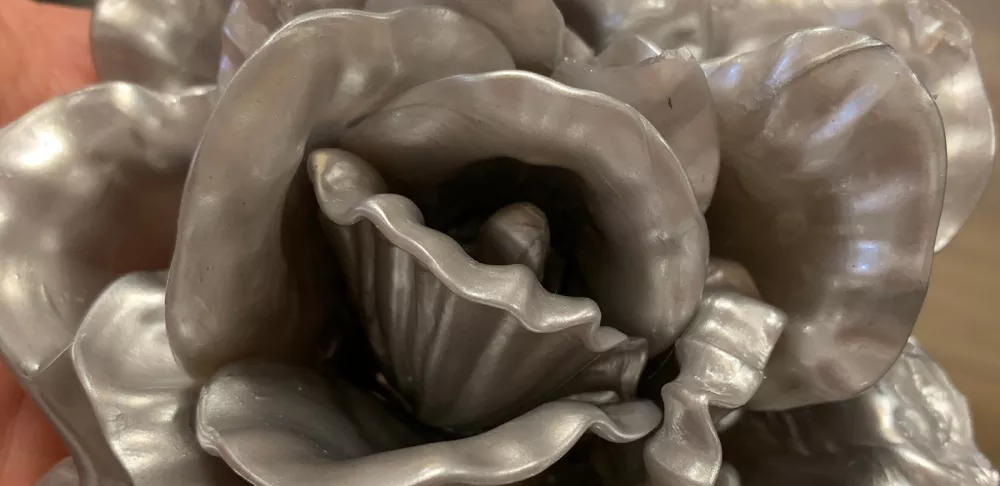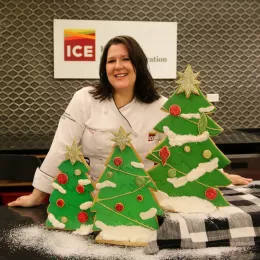As a cake artist, I think of mediums and techniques as my tool kit.
Each cake is new and requires thought on what would be the best way to make the items that tell that specific cake’s story.
I can make flowers from fondant, gum paste, modeling chocolate, tempered chocolate, bean paste or cold porcelain. And while few cake decorators touch it, I can pull and blow sugar into stunning florals that conjure feelings of lightness and delicacy that no other medium can.
Sugar work can transform florals and create simple bubbles or complex items. I’ve used it to make perfume bottles, windshields on a boat cake, ice in a champagne bucket, and of course, the bottle of champagne. Sugar work’s clarity and strength lends the art to become anything you need.
The technique can be intimidating. Sugar work is hot. It’s fragile. It requires practice and nuance. What can I say, I like to live on the edge. A bit of special equipment is useful, but not absolutely required. The weather can strongly affect the final pieces — humidity making them cloudy, heat making them sticky — so this is one time when I don’t recommend making items too far in advance.
When properly cooked and manipulated, the sugar can be clear like glass or opaque like smoke. While standard white sugar can be cooked for these kinds of applications, it’s mostly isomalt that is used for these outcomes. Isomalt is a sugar alcohol that was originally developed as a sweetener for diabetics. It was too costly to be used as a daily sweetener and instead became a favorite of showpiece-creating pastry chefs thanks to its ability to be cooked at a very high temperature before it caramelizes at over 400 F. It is not prone to crystallization so there is less fear in cooking it, and it will maintain its beauty and strength for longer periods of time.
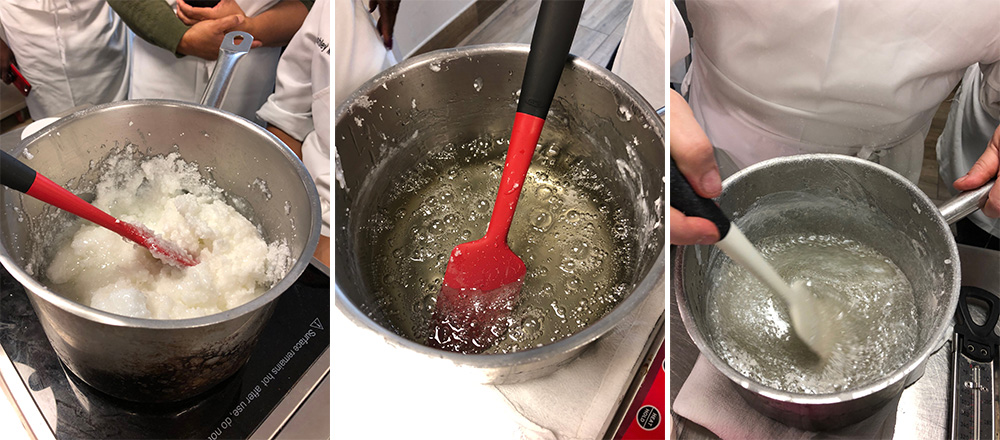
To cook isomalt, place it in a stainless steel sauce pan and add just enough water to create the texture of rough sand. Add too much water and you’re just spending useless time cooking it out. Cook the sugar over a medium heat until it has dissolved and reached temperatures of 320-360 F. I like 350 F for most things — I’ve always been a fan of making sure things are stronger than I need them to be. This should take a while; don’t rush it. No need to wash down the sides of the pot. This sugar is not going to re-crystallize in there.
When the sugar is cooked, you can add water-based colors. Generally, if you’re adding colors with liquid in them it’s a good idea to add them while the sugar is still cooking, about 120 F. This gives the water in the colors time to cook out. If I’m making more than one color from the batch, I can’t add it early, so finish cooking it and separate it, adding color after the isomalt has been fully cooked. There are colors formulated specifically for sugar work, and if doing work in bulk, I recommend them. But for standard cake items, gel pastes are great.
For the flowers I work with here, I add luster dust straight to the hot sugar. This gives a beautiful sheen, similar to the added air when the sugar is pulled. There is no need to handle the sugar so much to get that gorgeous sheen.
Allow the sugar to come down in temperature, about 275 F or so before you pour it and begin to work with it. This will allow time for any bubbles to dissipate and create a sugar that is ultra-clear. Always keep in mind the sugar is going to be very hot while you’re working with it and all caution should be taken.
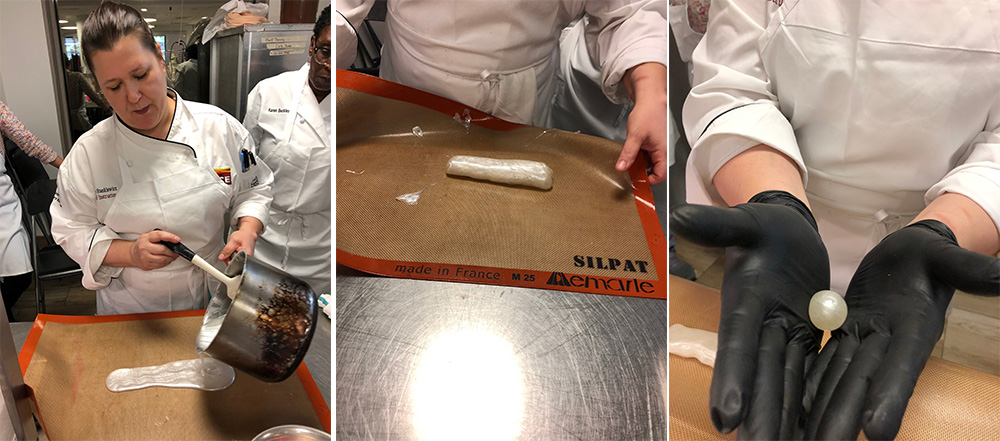
From here, you can pour it onto a Silpat and begin to work the sugar using the Silpat to fold it onto itself until it holds a mass. It is still very hot at this stage. Wearing one to three pairs of heavy-duty rubber gloves is essential.
When the isomalt is able to be handled but still pliable, you can begin to make the base and petals for your flower. Just like you would for a gum paste rose, make a cone from isomalt. Allow this to cool and set. Pull a small piece off of the log of hot sugar and form it into a thin petal shape between your fingers. Working quickly, while the sugar is still warm, you can press it into a petal press for texture. I pull most of my petals first and then begin to assemble. While working, it’s great to have a heat lamp to keep the sugar in working condition. Or get crazy and invest in a sugar-holding box. If these are not available, you can always reheat it in the microwave as needed to maintain its hot and pliable consistency. Be careful though, overdo it and you’re starting all over again.
To assemble the flower, have your petals and base ready on a Silpat and have a working, open flame. Spirit burners are great for this. A gas range or carefully watched torch can do the same work.
Make one last petal and while it’s still pliable, wrap it around the base in its entirety, overlapping the edge. Carry on attaching the petals as you would for a rose or flower in another medium, only this time, using the open flame to warm and soften the sugar at the base of the petal to be attached. Quickly add it to your base, building up until you feel the flower is complete.
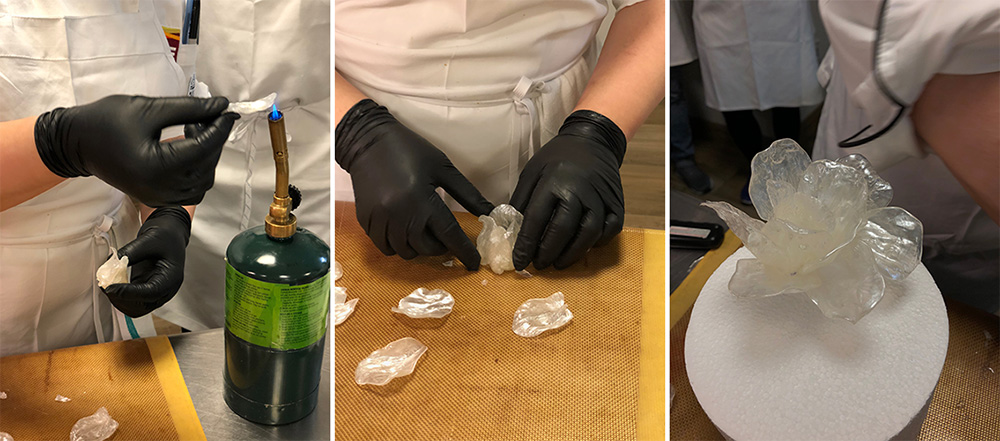
Completed isomalt pieces can be stored in an airtight container with a packet of desiccant to absorb moisture. Once the isomalt has been cooked, you never need to cook it again. Pour any excess on a Silpat or parchment paper and allow it to harden. I break it into manageable pieces and hold it in an airtight container. Next time, all I need to do is melt it to the right consistency and get to work.
Experimenting with isomalt and all its abilities to be pushed, pulled, blown and poured can add new levels to custom cake work. Think of it the next time you need a cake décor piece that will take your client’s breath away. Be fearless but not reckless and you’ll add a new technique to your tool box to make your cake work stand out from the competition.
Learn more modern cake artistry techniques from industry leaders in The Art of Cake Decorating.


